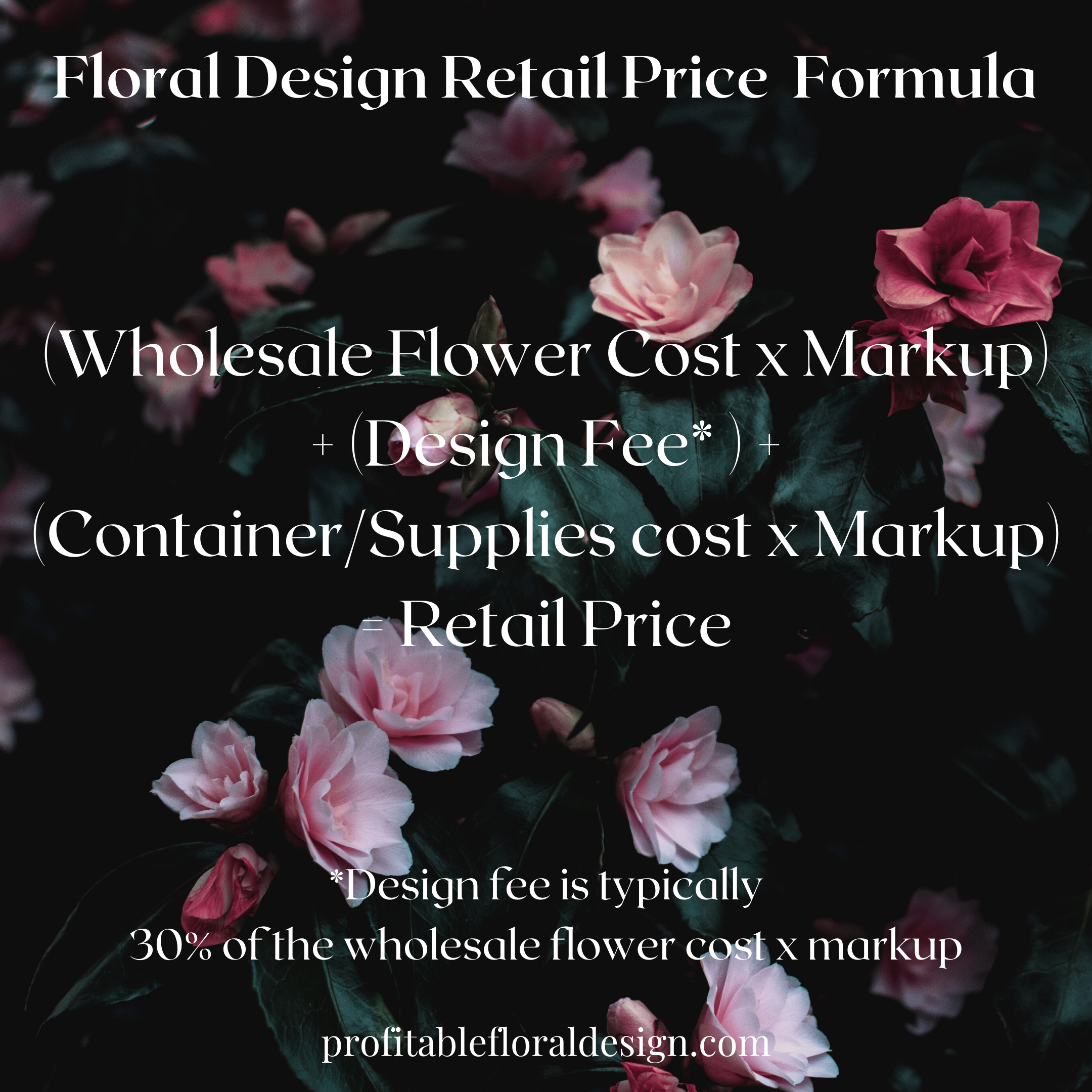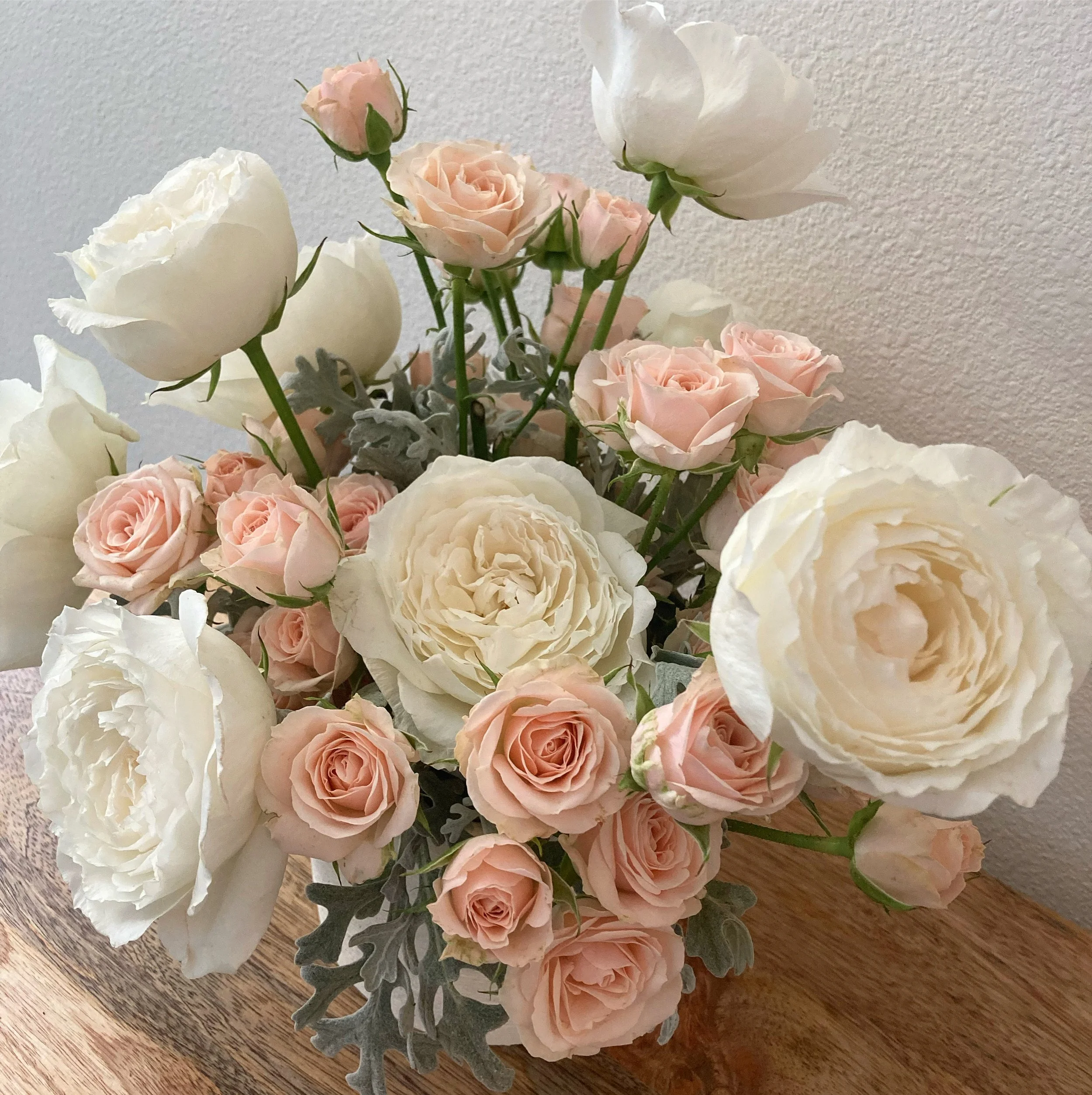Floral Pricing Guide: How Designers Price for a Profit…The Formula
The main way to increase your revenue to cover costs and pay yourself is, you guessed it, raise your prices! So, I’m here to talk you through the basics of pricing for a profit in this floral pricing guide.
6 Non-Negotiables When It Comes to Floral Arrangement Prices
Flower Costs
Vase/Container Costs
Other Supplies- this covers any non-floral non-vase materials including, but not limited to, wire, tape, chicken wire, flower-frog or kenzan, ribbon, etc.
Labor/ Design Fees
Overhead- this covers all your business costs like rent, marketing, water, internet, clippers, and knives…you get my drift.
Profit- the money you use to pay yourself and re-invest in your business.
How to price flowers?
You are creating works of art that enhance the human experience. Potential clients that want to express emotions through flowers see value in that art form. This means in exchange for that value they pay you for your time and a markup on your materials.
First off, I want you to know that a margin goal for each sale is an efficient way to ensure that you price every floral design for profit.
The goal of a 70% profit margin on the cost of your flowers and hard goods is the industry standard.
Margin is the percentage of your sales price that is profit. From this profit, you'll pay your overhead and expenses. The remainder is yours to take home or reinvest in your business.
The mark-up on your flowers is typically 3 to 4x your wholesale cost. The mark-up on your hard goods is usually 2 to 2.5x your cost. The design fee is based on your flower wholesale costs and is calculated as a percentage. This percentage typically starts at 30% and goes up from there depending on the complexity of the design.
If you you need more clarity around Flower Math , you can learn more from Alison Ellis of Real Flower Business . She offers online courses for florists interested in pricing for profit.
Don’t Compromise on Profits.
Of course, floral design price formulas do vary slightly. You may feel 3x markup is not enough because you are in an area with a higher cost of doing business. Your business may need to use a 4x or 5x markup on wholesale flowers to cover your costs and ensure a profit on every order. So, you’ll need to find the formula that works best for your business. This can be a bit of trial and error, but if you stick to the minimum of 3x wholesale flowers, 2x hard-goods, and a 30% design fee, you’ll be at the industry standard which is a great starting point.
How to price flowers for luxury events?
Custom floral designs are different than essential needs. They are custom-creations, unique works of art, each one-of-a-kind. Custom floral designs are typically purchased when there is an occasion, celebration, or emotional want in someone’s life. You must not only sell the product, the flowers themselves, but also the value they bring. It’s the experience, the service, and the emotional high that comes along with the flowers that drive the customer to pay a premium price. What do I mean by a premium price? Let me give you an example. A simple dozen roses at the grocery store retails for $25. A skilled designer who creates a custom arrangement with a dozen roses and other seasonal flowers should be charging somewhere around $125.
Your ideal customer is not looking for a quick bunch of flowers to toss in a vase. She’s looking for an experience.
Luxury floral design pricing language examples.
Solabee Flowers:
The descriptions of the beautiful designer's choice options on their website are filled with expressive phrases like “supporting the local farms that grow the fantastic blooms that make a Solabee arrangement so special” and “allow our floral designers to create something previously unimagined, especially for you.” draw the client into a luxury mindset.
How can Solabee’s customer not feel attended to after reading this? The price points seems so very reasonable for such luxe blooms designed by-hand. They are using the both concepts of pricing for profit and selling their customers on the premium features of their bespoke floral designs at the same time!
Amy McLaughlin Flowers:
This sales page draws the customer in with a promise that “each arrangement is custom designed by the owner and crafted to tell its own special story”.
Amy continues to sell her price point by describing her containers as being unique hand-crafted pieces. Then, she wraps it up neatly by assuring her customer that the “florals will exude feelings of joy and gratitude” and “will take the recipient’s breath away”. The epic sized arrangement is clearly worthy of this enticing description.
How to Sell Your Price?
So, the way to sell flowers is not by price alone, but by conveying the value, skill, and experience you put into your floral design. The emotional nature built into the reasons why people buy flowers is what drives the industry. Use that to ensure you are expressing value through your prices and make sure your customers experience a level of service above their typical purchase experience. That's how you give them an experience they will feel confident is worth the price!
Use language that Sells the Experience.
You’ll want to look at your offerings and start to use language that sells the experience of sending and receiving flowers.
So, you must use descriptive words to describe your floral design skill and level of commitment to the craft. This descriptive language grabs the customer’s attention and heightens their purchasing experience.
Photos alone cannot tell the story of a $125 dozen rose arrangement. Yes, it’s beautiful. But why should they spend $125 when they can get that $25 grocery store arrangement?
Give them a reason to buy. Tell them it’s because each bloom is hand-selected for quality and freshness. Explain that the design is composed of locally grown blooms and set into a hand-crafted ceramic vase that will delight her. That is how you sell your floral designs at prices that will allow you to pay yourself and reinvest in your business.
If you’d like to learn more about the profit pitfalls that floral designers often fall into check out my Is Owning A Flower Shop Profitable blog post next!
Until next time,
LuAnn
We independently review everything we recommend. Some of our posts may contain affiliate links. If you use these links to buy something we may earn a commission. Thanks.
EveryStem Pricing Software
It allows you to confidently price your floral designs for a profit and build your flower orders in minutes, not hours. Finally makes flower recipes and wholesale orders easy!
- ✔ Pricing & Stem Calculator
- ✔ Profit & Budget Tracker
- ✔ Easy Wholesale ordering!
- ✔ Customizable Flower Library
- ✔ Create and Repurpose Flower Recipes
- ✔ Florist Business Coaching & Support
FAQs
-
As a freelance florist I can say from personal experience in my area that most florists charge between $20 and $60 per hour to design for weddings and events. But as a business owner I can say from personal experience that most florists charge for labor as a percentage of either each design or a percentage of the total price for all the designs for an event. This labor or design fee percentage typically ranges from 30% to 50% depending on the intensity of the design, requirements, and time the design will take to create.
Alternatively, some florists charge for their time by the hour and this is something that you can use EveryStem florist software to calculate and you can learn how to do that in this video!
How much to charge your client per hour of work is something you’ll need to determine based on your income goals and your costs, but I have seen these hourly costs range widely depending on location and level of service. Taking the hourly pay for an employee and adding a 2x to 4x markup is not uncommon for florists who are calculating their labor by the hour.
As a florist you can consider and experiment with both options to see which works best for your business.
-
Don’t use guesswork to determine the amount you should charge for a flower arrangement! Guesswork is what gets florists into a habitual cycle of under-charging and over-filling flower arrangements. Instead, follow my flower pricing guide formula! To make it easier you can use EveryStem florist software to enter the flowers you plan to use in the arrangement quickly and easily, then add your hard goods, and let the software calculate the price you should charge based on your markup and your labor fee.
Two benefits to doing it this way are…
1. you avoid mistakes because the computer does the math for you.
2. you have the recipe and pricing saved for future use.
And if you are just starting out in floral design and feel you aren’t ready for EveryStem yet, save and follow the formula above to do the math by-hand until you are ready for florist software. But don’t forget to double check your math before you share your price!
-
A good profit margin to aim for as a florist is 70% on the cost of flowers and supplies, but just like everything else in small business this is not a hard rule.
Why? Because some florists work well on a lower profit margin by selling lots and lots of flowers, while others work on a higher profit margin because they have very high overhead costs and need to cover those costs plus make a healthy profit.
Consider your costs using the EveryStem Profit Summary and you’ll be able to determine if you need to aim for 70% profit margin or if a higher or lower profit margin would be more suitable for your business.
-
A floral budget is something that you determine when you price out a design for a client or for one of your offerings.
Here is a simple process for how you determine a floral budget for a client.
Step 1. Understand the requirements of the design.
Some things you want to understand about the floral request are the size, scale, general color palette, and a general idea of flower varieties you plan to use. This can be a combination of inputs from your client and your creative ideas.
Step 2. Use those requirements to build a recipe and apply your flower pricing formula.
In EveryStem for example you can create an event template with your markups and labor fee, make a copy of it, and add the flowers and hard goods for your design into a recipe column. Then you simply type in your estimated quantities of each item in the recipe.
Step 3. The costs of that recipe are your floral budget. This is the amount of money you plan to spend at wholesale on your design. If you are quoting for a design that will be made months from now, you may also want to add a buffer to ensure you don’t go over-budget if wholesale prices increase between now and then.
That’s it. It’s quite simple when you use a software that was made by a florist for florists!
Remember to take a little time for self-care this week. Even floral designers need to stop and smell the roses!





